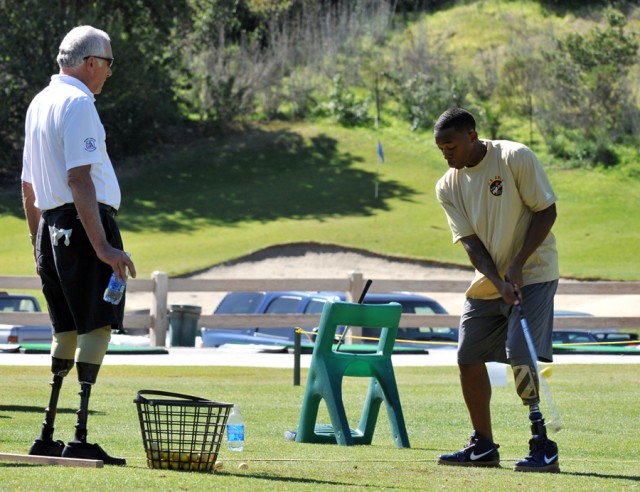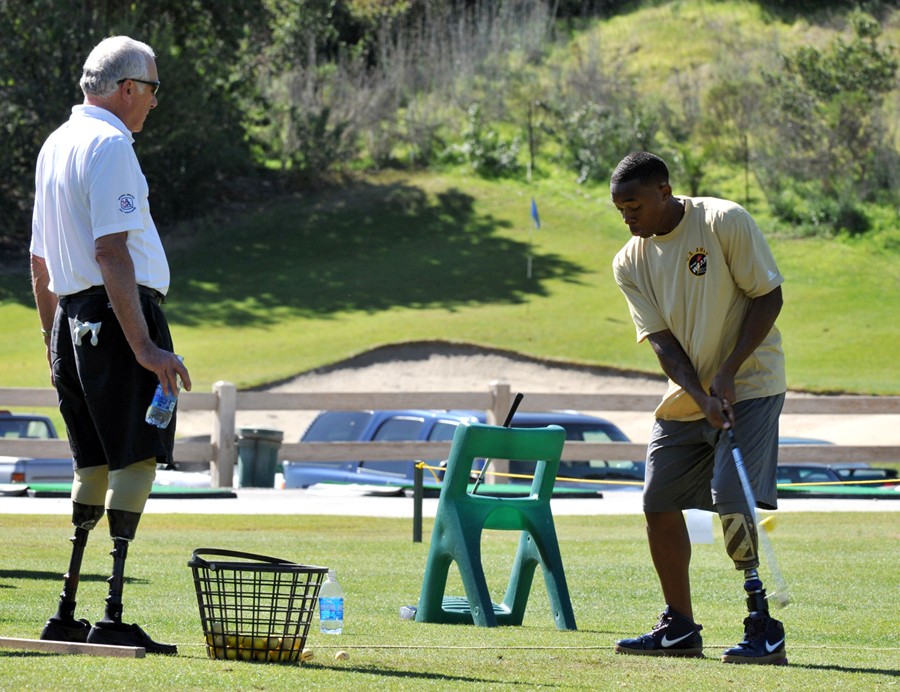
SAN DIEGO (Army News Service, Feb. 5, 2009) -- U.S. Army World Class Athlete Program track and field Paralympics hopeful Sgt. Jerrod Fields will never forget his first swing at a golf ball.
Fields, an all-around athlete who lost his lower left leg to an improvised explosive device in Baghdad, took his first whack at golf Feb. 3 on the driving range at Admiral Baker Golf Club.
While television news cameras filmed and newspaper photographers clicked away, Fields stepped up to the tee as if he does it every day.
"I kind of pumped myself up," he said. "When I saw the cameras on, I was like, 'OK, let's get it.' You never know who is watching and where it's going to end up."
As if there was not already enough pressure, 14 PGA-certified instructors loomed over his shoulder.
"This was a blast," Fields said. "First time playing golf, and having a camera crew out here and professionals to help me with the golf swing, it was awesome.
"Meeting professionals, I'm all for it," continued Fields, 26, a Chicago native stationed at Fort Carson, Colo., who is based at the U.S. Olympic Training Center in Chula Vista, Calif. "One day I desire to meet different sports figures: Tiger Woods, LeBron James and other various athletes. They might see this and I might get a call or something."
In the meantime, Fields urges every wounded warrior in the U.S. military to take advantage of the First Swing program.
The National Amputee Golf Association's First Swing Learn to Golf program is presented by the Army Family and Morale, Welfare and Recreation Command and the United States Golf Association. The purpose is to encourage wounded service members to return to an active lifestyle as soon as they are able, by assisting them in adapting their golf game to compensate for their injuries.
"Fort Carson conducted a First Swing pilot program last July and we saw the success that the team had with the wounded warriors there," said Trace Kea, a PGA member and program analyst at FMWRC. "So FMWRC decided to partner with them and the USGA to take this program to several different installations."
"This program is to help give the Soldiers an alternative," Kea said. "Rehabilitative benefits of golf can improve the mental and physical condition of each and every Soldier returning... not just those with visible injuries."
"I've seen nearly every type of injury on the driving range, from double- or triple-amputees playing with state-of-the-art prosthetics, to others with shrapnel wounds, spinal-cord injuries, and neurological deficits," Kea said. "Many of our Soldiers suffer from post-traumatic stress disorder. Seeing those men and women playing touched me, and I knew we had to get involved."
The First Swing tour has scheduled stops in Fort Sam Houston, Texas, Feb. 21-23; Fort Belvoir, Va., March 22-24; Fort Bragg, N.C., April 19-20; Fort Campbell, Ky., May 10-11; Fort Lewis, Wash., July 18-19; and Fort Jackson, S.C., Sept. 13-14.
Fields joined the Army in November of 2002, deployed to Baghdad in January of 2005, and was injured a month later. He rehabbed at Walter Reed Army Medical Center in Washington.
"Initially, they're probably a little afraid," he said of the prospect of fellow amputees getting back into the swing of athletics. "Just talking to some of my friends who were injured, they do really not want to get out - (they're) just afraid of not being able to do what they want to and once could do.
"If they were a golfer or played a certain sport... and they get out there and are not be able to do it at the level at which they once did, it can be scary. (I think) they kind of shy away from it at first, until they get more and more comfortable.
"It's just a matter of being patient with getting us out here because it is a huge step for us."
Fields, who played football, basketball and baseball at Carver High School in Chicago, suggests that wounded warriors should take the step as soon as physically possible.
"I would say to get out here and face those fears, if any, and have fun," he said. "This beats being in a house and being depressed, or being off your leg or your arm, or thinking how people might view you because of your disability. Just get out here and have fun."
Fields, whose No. 1 passion is basketball, belongs to an organization called Amp1, a takeoff of the And1 group.
"We got a few guys in Oklahoma, Texas, Florida, New York - different types of amputees all over the country - to just come out and play basketball," he explained. "I'm going to play a 3-on-3 tournament in Texas on March 4.
"Four of us meet here in San Diego and we try to get some games in - mostly against able-bodied athletes. We try to go after two-legged people. That's what we call them," he said with a grin. "It really does put your mind at ease. I remember playing basketball when I constantly thought about my leg, and I made a move and I didn't think about it, and it was the best move I ever made.
"There comes a time in the sport where you're not even aware that you're an amputee or that you have a disability. So when I got out here (on the driving range), especially when they taught me how to do the follow through and the turn, I forgot I was an amputee. I'm just like anybody else. Why can't I hit it' I felt equal. I felt like I was a golfer, and not an amputee."
Fields dazzled the instructional golf professionals with his poise and athleticism.
"That was phenomenal for a first-time try at the game of golf, which is so demanding," said one-armed Navy veteran Rick Monroe, who lost the use of one arm 30 years ago through an accident on the USS Enterprise. "It was obvious that his athleticism was really kicking in, and his attitude was always 'can do,' so that's good to see."
Monroe, 57, of Austin, Texas, said he derives more satisfaction from giving back to the troops than they could ever imagine.
"I always feel like I get more out of it than they do, absolutely, because if I can communicate anything to these guys, it is that a good life is still possible for them," he said. "Obviously, golf is a great game, but it's also a lifetime game, so by communicating that to them so they don't have to sit on the couch and drink themselves into a stupor every night or whatever, they can be active, productive and live a good life."
National Amputee Golf Association Executive Director Bob Wilson, a retired Navy lieutenant commander who lost both of his lower legs while serving aboard the USS Kitty Hawk, also was impressed with Fields' golf debut.
"He's an athletic dude," Wilson said. "He's got the moves. I think he only needed pointers in order for him to hit the ball. He whiffed the first one, and then hit the second one, and the smile on his face just said it all. I don't know if it's going to be his prime endeavor, but at some point I think he's probably going to end up playing golf."
A Navy retiree approached Fields in the parking lot after the clinic and told him he heard that Fields had just made his debut on the driving range.
"Don't do it," the old-timer said. "It's worse than dope, the hard stuff - because once you do it, you're hooked."
"I already am," Fields replied.
"Are you married'" the retiree asked.
"Yes, sir," Fields said.
"You'll be divorced soon," the old man said with a boisterous laugh - before changing his tune and bragging about many decades spent with his wonderful wife.
"Today was my first time picking up a golf club and swinging it," Fields concluded. "It felt good. It automatically drew me into the game, making me really want to put the ball in the hole."
Fields then retreated to the Olympic Training Center weight room to get in another workout before heading home to wife Kirra and their daughters, Janyia, 2, and Janise, 1.
"My job is actually my break time," he said with a smile. "I go to work when I go home."
(Tim Hipps writes for FMWRC Public Affairs.)

Social Sharing